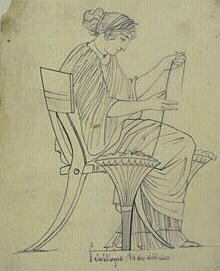Penelope
In folk etymology, Pēnelopē (Πηνελόπη) is usually understood to combine the Greek word pēnē (πήνη), "weft", and ōps (ὤψ), "face", which is considered the most appropriate for a cunning weaver whose motivation is hard to decipher.
Penelope is married to the main character, the king of Ithaca, Odysseus (Ulysses in Roman mythology), and daughter of Icarius of Sparta and Periboea (or Polycaste).
She waits twenty years for Odysseus' return, during which time she devises various cunning strategies to delay marrying any of the 108 suitors (led by Antinous and including Agelaus, Amphinomus, Ctessippus, Demoptolemus, Elatus, Euryades, Eurymachus and Peisander).
[11] But because Athena wants her "to show herself to the wooers, that she might set their hearts a-flutter and win greater honor from her husband and her son than heretofore", Penelope does eventually appear before the suitors [11](xviii 160−162) Irene de Jong wrote As so often, it is Athena who takes the initiative in giving the story a new direction ... Usually the motives of mortal and god coincide, here they do not: Athena wants Penelope to fan the Suitors’ desire for her and (thereby) make her more esteemed by her husband and son; Penelope has no real motive ... she simply feels an unprecedented impulse to meet the men she so loathes ... adding that she might take this opportunity to talk to Telemachus (which she will indeed do).
Penelope and the suitors know that Odysseus (were he in fact present) would easily surpass them all in any test of masculine skill, so she may have started the contest as an opportunity for him to reveal his identity.
Having done so, he proceeds to slaughter the suitors – beginning with Antinous whom he finds drinking from his cup – with help from Telemachus, Athena and the slaves Eumaeus the swineherd and Philoetius the cowherd.
Odysseus has now revealed himself in all his glory (with a little makeover by Athena); yet Penelope cannot believe that her husband has really returned – she fears that it is perhaps some god in disguise, as in the story of Alcmene – and tests him by ordering her slave Eurycleia to move the bed in their bridal-chamber.
[16] Homer implies that from then on Odysseus would live a long and happy life together with Penelope and Telemachus, wisely ruling his kingdom, and enjoying wide respect and much success.
[17] Penelope also appears in the lost Greek epic Telegony that does not survive except in a summary, but that was attributed to Eugamon or Eugammon of Cyrene and written as a sequel to the Odyssey.
Odysseus and his oldest son, Telemachus, defended their city and, in the ensuing melée, Telegonus accidentally killed his father with a lance tipped with the venomous spine of a stingray.
[29] Penelope is recognizable in Greek and Roman works, from Attic vase-paintings—the Penelope Painter is recognized by his representations of her—to Roman sculptures copying or improvising upon classical Greek models, by her seated pose, by her reflective gesture of leaning her cheek on her hand, and by her protectively crossed legs, reflecting her long chastity in Odysseus' absence, an unusual pose in any other figure.






